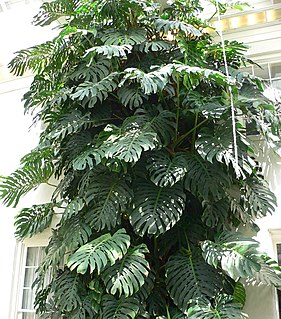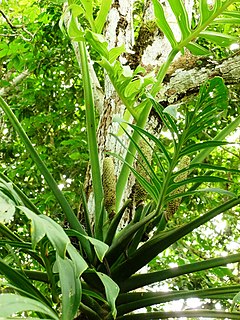
Mönsterås Municipality is a municipality in Kalmar County, south-eastern Sweden, with its seat located in the town Mönsterås.

Monstera deliciosa, the Swiss cheese plant or split-leaf philodendron is a species of flowering plant native to tropical forests of southern Mexico, south to Panama. It has been introduced to many tropical areas, and has become a mildly invasive species in Hawaii, Seychelles, Ascension Island and the Society Islands. It is very widely grown in temperate zones as a houseplant.
Swiss cheese plant may refer to:

Monstera is a genus of 45 species of flowering plants in the arum family, Araceae, native to tropical regions of the Americas. The genus is named from the Latin word for "monstrous" or "abnormal", and refers to the unusual leaves with natural holes that members of the genus have.

A hemiepiphyte is a plant that spends part of its life cycle as an epiphyte. The seeds of primary hemiepiphytes germinate in the canopy and initially live epiphytically. They send roots downward, and these roots eventually make contact with the ground. Secondary epiphytes are root-climbers that begin as rooted vines growing upward from the forest floor, but later break their connection to the ground. When this happens, they may send down long roots to the ground.

Epipremnum is a genus of flowering plants in the family Araceae, found in tropical forests from China, the Himalayas, and Southeast Asia to Australia the western Pacific. They are evergreen perennial vines climbing with the aid of aerial roots. They may be confused with other Monstereae such as Rhaphidophora, Scindapsus and Amydrium.

Monsteroideae is a subfamily of flowering plants in the family Araceae.

Monstera epipremnoides is a species of flowering plant in the family Araceae, endemic to Costa Rica. A clone in cultivation was formerly thought to be of this species, but after comparison with wild populations of M. epipremnoides, the plant in cultivation has since been registered as a cultivar of the name Monstera 'Esqueleto'.

Monstera adansonii, the Adanson's monstera, Swiss cheese plant, or five holes plant, is a species of flowering plant from family Araceae which is widespread across much of South America and Central America. Besides South American countries it can also be found in the West Indies on islands such as Antigua, Grenada, Saba, St. Kitts, Guadeloupe, Marie Galante, Dominica, Martinique, St. Lucia, St. Vincent, Tobago, and Trinidad. The species is quite common near river valleys at lower elevations.
Monstera standleyana, the five holes plant is a species of flowering plant from family Araceae which can be found in Costa Rica, Honduras, Nicaragua, and Panama. It was described by G.S. Bunting in 1967.
Monstera acuminata, or shingle plant, is a species of flowering plant from family Araceae which is widespread from Mexico to Central America. It is abundant in central Petén and extends north to San Luis Potosí, making it the northernmost of the species of Monstera.

Monstera dubia is a species of plant in the genus Monstera native to Central and South America. M. dubia is known for the dramatic transformation its foliage makes as it climbs from seed stage on the forest floor, to shingling closely up a host tree trunk or other surface, until mature leaves with fenestrations similar to Monstera deliciosa appear.

Monstera obliqua is a species of the genus Monstera native to Central and South America. It is hemiepiphytic like most other Monstera species. The plant is particularly known for its foliage, which is often highly perforated, sometimes described as having more empty space than leaf. An illustration of the general variation in adult leaf shape from different individuals of this species can be found in Michael Madison's 'A Revision of Monstera'. The species is not commonly cultivated, but the name is often misapplied to specimens of the more widespread Monstera adansonii.

Monstera siltepecana is a species of flowering plant in the genus Monstera native to southern Mexico and Central America. Like other Monstera species, it is a vining plant and as it matures, develops holes in its leaves. Especially in immature foliage, it has distinctive silver venation.

Monstera pinnatipartita is a species of flowering plant in the genus Monstera native to Central America and the tropical areas of South America. Like the more common Monstera deliciosa the plant has green foliage that becomes highly fenestrated when mature, though both immature and mature leaves are less heart shaped. Its name refers to the deeply split mature leaves that are pinnate.

Monstera acacoyaguensis is a flowering plant in the family Araceae and the genus Monstera. its native range is Mexico (Chiapas) to Belize.
Monstera amargalensis is a flowering plant that belongs to the genus Monstera, and the family Araceae.

Monstera anomala is a flowering plant of genus Monstera and family Araceae.
Monstera oreophila is a flowering plant in the genus Monstera and family Araceae.












